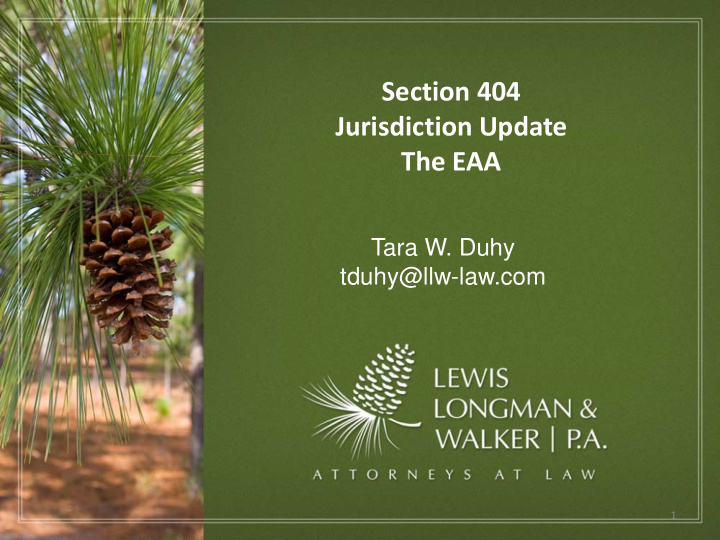



> Section 404 Section 404 Jurisdiction Update Jurisdiction Update The EAA The EAA Tara W. Duhy tduhy@llw-law.conn Tara W. Duhy tduhy@llw-law.com LEWIS I**'? LONGMAN & WALKER RA. i ¦ ' ATTORNEYS AT LAW 1
Section 404 – Why You Care? • Mining involves an inevitable competition for resources: – Mining is necessarily “place ‐ based” – Development pressure – Conservation/water quality and quantity concerns • This competition plays out through the environmental permitting process, including the CWA Section 404 permitting process 2
CWA 404 Jurisdiction: The Basics “Waters of the United States” • Do not include “Prior Converted Cropland” • Include some wetlands – Wetlands with continuous surface connection and/or adjacent to TNW and relatively permanent tributaries to TNWs – Other wetlands that have “significant nexus” to TNW or relatively permanent tributary to TNW • Does not include “isolated” wetlands ( SWANCC ) 3
^a ^^ LEWIS LONGMAN & Significant Nexus??? - WALKER I RA, Significant Nexus??? ATTfJRNtVS AT IAW 4
Case Law Update: Precon Development Corp v. U.S. Army Corps of Engineers – U.S. Court of • Appeals, 4 th Circuit, January 25, 2011 – Challenge to the Corps’ assertion of jurisdiction over 4.8 acres of wetlands located approximately 7 miles from nearest navigable water – At issue – did Corps determine proper “reach” to analyze and did undisputed record evidence establish “significant nexus”? – Court ruled: • Reach was appropriate • Significant nexus was not established – Corps need not engage in quantitative analysis, but must provide “some evidence not only of the functions of the relevant wetlands and their adjacent tributaries, but of the condition of the relevant navigable water” 5
..ts ^^ LEWIS LONGMAN & A Special Case: The EAA WALKER | RA. A Special Case: The EAA AT iNEYS AT IAW ¦M ^ y. i «...•¦¦=- —ap : •¦ ii= l"lr*" £3%\- ¦ - 1 IH ^ ^ii4l.i ^ISi 31 ^f-l b! "-- .. ¦ ¦I" llnil.!!! amosasipcs SttGimfliro 6
Background � A National Campaign to drain the EAA began as early as the mid 1800s � Drainage infrastructure facilitated agriculture (sugar) within the EAA beginning in the 1920s � In 1948 Congress approved the Central and Southern Florida Project for Flood Control and Other Purposes (C&SF Project) � The C&SF Project constructed over 1,000 miles of canals, and hundreds of pumping stations and levees within three decades 7
The Issue: Under 33 C.F.R § 328.3(a)(8) (1993), “waters of the United States • do not include prior converted cropland” and the Corps does not have jurisdiction • In January 2009, the Corps issued a policy stating that once prior converted cropland shifts to a non ‐ agricultural use, the Corps can regulate it • Policy also assumed existing cropland would revert to wetlands if individual pumping ceased – Attempted to define jurisdiction of historically drained agricultural land using “atypical situation” section of Wetland Delineation Manual 8
The Challenge: • Federal Lawsuit filed challenging the Corps action: 1. Was the Corps promulgating a new rule regarding Prior Converted Croplands without going through the appropriate process? 2. Could the Corps presume jurisdiction over the EAA based on a the “atypical situation” portion of the Wetland Delineation Manual by asserting the historic pumping within the EAA constitutes “recent human activity”? � Allows assertion of jurisdiction without requiring the presence of all three wetland indicators – hydrology, vegetation and soil 9
The Verdict: New Hope vs. U.S. Army Corps of Engineers, September 14, 2010 Decision : Federal District Court Judge K. Michael Moore held that the U.S. Army Corps of Engineers’ position was inconsistent with existing written regulations, and this new policy constituted binding new regulations which the Corps was now imposing without following the notice, comment and rule adoption procedures required of such new rules. Judge Moore also issued an injunction barring the Corps from applying its new policy until such time as it follows the required rulemaking process. 10
Any Questions? Tara W. Duhy tduhy@llw ‐ law.com LEWIS, LONGMAN & WALKER, P.A. 515 N. Flagler Drive, Suite 1500 West Palm Beach, Florida 33401 Phone: 561 ‐ 640 ‐ 0820/Fax: 561 ‐ 640 ‐ 8202 www.llw ‐ law.com 11
Recommend
More recommend